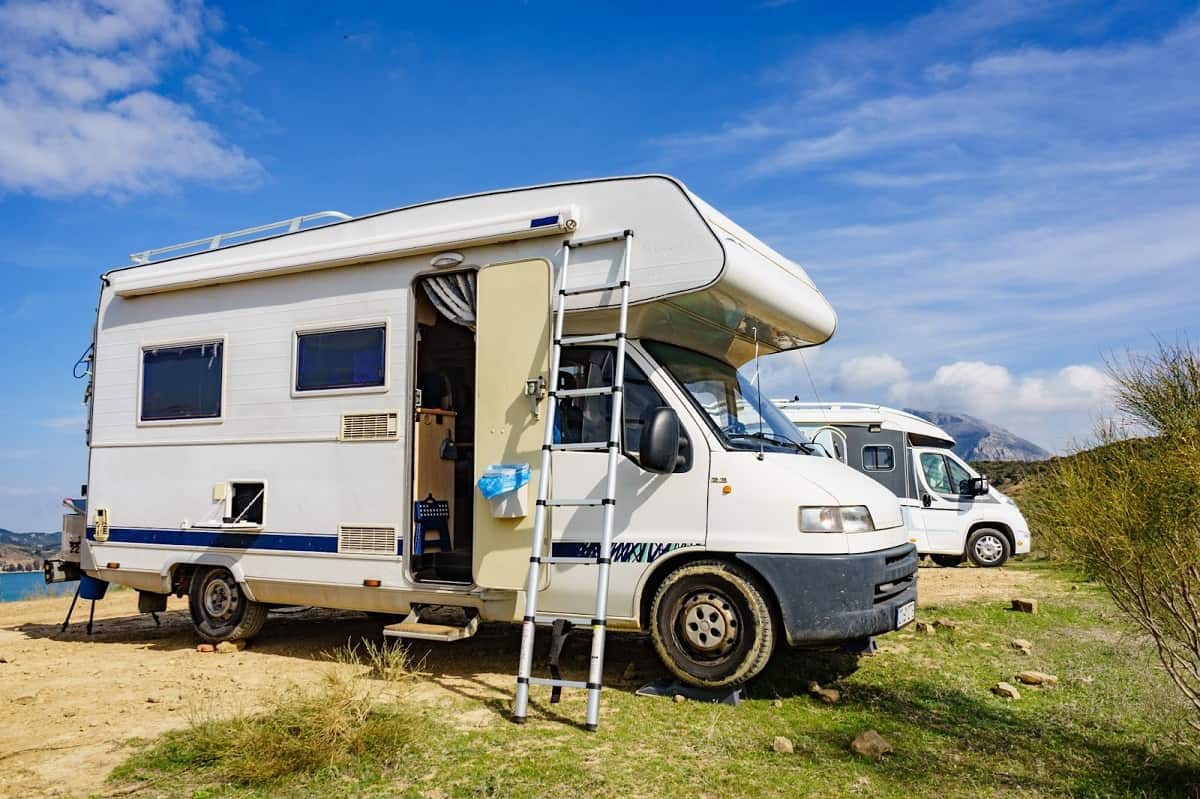You don’t exactly see your RV roof… and as a result, it’s easy to let it go neglected. But in fact, it’s absolutely crucial to regularly clean your RV roof. If you don’t, you could wind up with a leaky RV with a reduced resale value and potentially expensive repairs if the situation gets serious enough.
Thankfully, cleaning your RV roof is easy. In this guide, we’ll walk you through every step of how to clean an RV roof so you can keep it in tip-top shape for years to come.
Why Cleaning Your RV Roof is Crucial
If you don’t clean your RV roof, it’s prone to wear down much more quickly. One of the biggest concerns is developing leaks. If your RV roof becomes damaged, your RV can quickly develop leaks, leading to water intrusion into your RV.
This water intrusion can lead to massive damage to the interior of your RV. Mold growth, delamination, discoloration, and damaged interiors and cabinetry are all potential problems. If water intrusion goes on long enough unchecked, it could even damage your RV past the point of no return.
Types of RV Roofs
There are a variety of different materials that can be used to make the roof of your RV. Which material your RV has affects how you clean your RV roof. The most common materials are different forms of rubber, but there are other materials used too.
EDPM or TPO Rubber
Those acronyms stand for Ethylene-propylene Diene Monomer and ThermoPlastic Olefin, respectively. These are the two most common RV roof materials. They have slightly different properties, but by and large, both are affordable, lightweight, and long-lasting.
PVC
PVC stands for PolyVinyl Chloride. This is the same material as PVC piping but in a slightly different form. PVC roofs are fairly durable and resistant to UV rays.
Fiberglass
Fiberglass RV roofs are made with layers of fiberglass material, much like the more common fiberglass RV bodies. This material is tough and lightweight. However, it can be expensive to fix, and it can be sensitive to high temperatures.
Aluminum
Perhaps the least common material for RV roofs is aluminum. Aluminum RV roofs are durable and long-lasting, but they’re also heavy.
Preparation Steps for Cleaning Your RV Roof

Before we get into how to clean an RV roof, let’s look at what you’ll need to have ready to go. Here is a list of supplies you’ll need to clean your RV roof:
- Medium bristle brush for rubber roofs or a soft cloth
- An appropriate cleaner for your roof material
- Broom or leaf blower
- A hose with a water connection
- Protective coating or wax (if you’ll be applying it)
Pay special attention to the cleaner you choose, and ensure it’s appropriate for your RV roof. If in doubt, your RV’s manual will likely provide information on appropriate cleaners and other insights into maintaining your RV’s roof.
You’ll also want to take special precautions to keep yourself safe while on your RV’s roof:
- If you’re using a ladder that’s not attached to your RV, ensure the ladder is stable and secure. Double-check it before going up or down.
- Wear shoes with grippy soles that aren’t worn down
- Hoist cleaning supplies up with a rope, or have somebody else help you get them up
Keep in mind that if your RV doesn’t have a built-on ladder, the roof may not be designed to be walked on. If this is the case, consider using a couple of pieces of plywood or particle board to spread out your weight. If unsure, check your manual for more information.
Step-by-Step Guide on Cleaning

With everything prepared, you’re ready to get to the actual cleaning. Let’s break down how to clean an RV roof step by step.
Step 1: Sweep Off the Roof and Hose It Down
Before you get to deep cleaning your RV roof, you want to remove dirt and debris that could scratch the surface. The simplest way to do this is using a broom, but you can also use a leaf blower. Get onto the roof, remove any large objects like branches by hand, and sweep off the rest.
Next, spray down the roof with a hose.
Step 2: Clean the Roof with the Appropriate Cleaner
Now it’s time to get into the real cleaning. That means sudsing the roof up, scrubbing with a medium bristle brush or soft cloth, rinsing it, and letting it dry. Because RV roofs tend to be fairly large, it’s recommended to work in 3 to 4 sq ft sections.
As mentioned before, you need to use an appropriate cleaner for your roof material. Here’s an overview of what type of cleaner you should be using based on the type of RV roof you have:
- EDPM or TPO Rubber RV Roof – When cleaning your RV’s rubber roof, it’s important to do so regularly for optimal maintenance. As recommended by KOA RV Services, rubber roofs should be cleaned three to four times a year using a non-abrasive cleaner and a medium bristle brush. Equally crucial is to avoid cleaners containing petroleum solvents, harsh abrasives, or citrus ingredients, as these can cause permanent damage to the rubber surface.
- PVC RV Roof – These roofs are easy to clean, because the material is not sensitive to most common cleaners. Use any mild soap and medium-bristle brush, and you’re good to go.
- Fiberglass RV Roof – Fiberglass is a bit more sensitive, so use a fiberglass cleaner or a very gentle soap. Over time, fiberglass can start to “chalk,” causing white residue to streak down the sides of the RV. To avoid this: clean, buff, and coat the roof with an appropriate wax.
- Aluminum RV Roof – These roofs aren’t common, but if you have an Airstream or similar trailer, then your roof is likely aluminum. Use a designated aluminum cleaner or a very mild soap, and avoid using anything abrasive, as scratches can be particularly visible on aluminum.
Post-Cleaning Maintenance
Once the roof is clean and dry, the next step is to do an inspection. Look for any holes in the seals around accessories like the air conditioner unit, air vents, or skylights. While you’re up there, check to make sure the sealant isn’t peeling.
If you do find damaged sealant, this is the perfect time to replace it! Use a self-leveling sealant for horizontal surfaces, and a non-sag sealant for vertical surfaces.
Some materials, particularly rubber RV roofs, benefit from periodic treatment with a protective UV coating. Check your manual, but this should be applied at least every two years to extend the life of the roof.
Regardless of your roof type, park your RV in a shaded area whenever possible. You should also consider using a tarp, RV cover, or structure to cover your RV roof, especially if you’re in an area prone to heavy rain or hail. This will protect your roof from the elements, ensuring a long lifespan.
Cleaning Your RV Roof Regularly is Essential
Without regular cleaning, your RV roof can quickly become damaged and spring leaks, costing you serious money down the line. To avoid this, clean your RV periodically, ensuring you use a cleaner appropriate for your roof material. Your RV roof will thank you!





Those of us who have Montana RV”s were told to use Dawn liquid detergent to clean our roofs. Have been doing that for years.